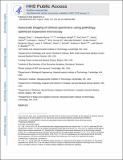Nanoscale imaging of clinical specimens using pathology-optimized expansion microscopy
Author(s)
Zhao, Yongxin; Bucur, Octavian; Irshad, Humayun; Chen, Fei; Weins, Astrid; Stancu, Andreea L; Oh, Eun-Young; DiStasio, Marcello; Torous, Vanda; Glass, Benjamin; Stillman, Isaac E; Schnitt, Stuart J; Beck, Andrew H; Boyden, Edward S; ... Show more Show less
DownloadAccepted version (1.326Mb)
Terms of use
Metadata
Show full item recordAbstract
Expansion microscopy (ExM), a method for improving the resolution of light microscopy by physically expanding a specimen, has not been applied to clinical tissue samples. Here we report a clinically optimized form of ExM that supports nanoscale imaging of human tissue specimens that have been fixed with formalin, embedded in paraffin, stained with hematoxylin and eosin, and/or fresh frozen. The method, which we call expansion pathology (ExPath), converts clinical samples into an ExM-compatible state, then applies an ExM protocol with protein anchoring and mechanical homogenization steps optimized for clinical samples. ExPath enables ~70-nm-resolution imaging of diverse biomolecules in intact tissues using conventional diffraction-limited microscopes and standard antibody and fluorescent DNA in situ hybridization reagents. We use ExPath for optical diagnosis of kidney minimal-change disease, a process that previously required electron microscopy, and we demonstrate high-fidelity computational discrimination between early breast neoplastic lesions for which pathologists often disagree in classification. ExPath may enable the routine use of nanoscale imaging in pathology and clinical research.
Date issued
2017Department
Massachusetts Institute of Technology. Media Laboratory; Massachusetts Institute of Technology. Department of Biological Engineering; McGovern Institute for Brain Research at MIT; Massachusetts Institute of Technology. Department of Brain and Cognitive SciencesJournal
Nature Biotechnology
Publisher
Springer Science and Business Media LLC